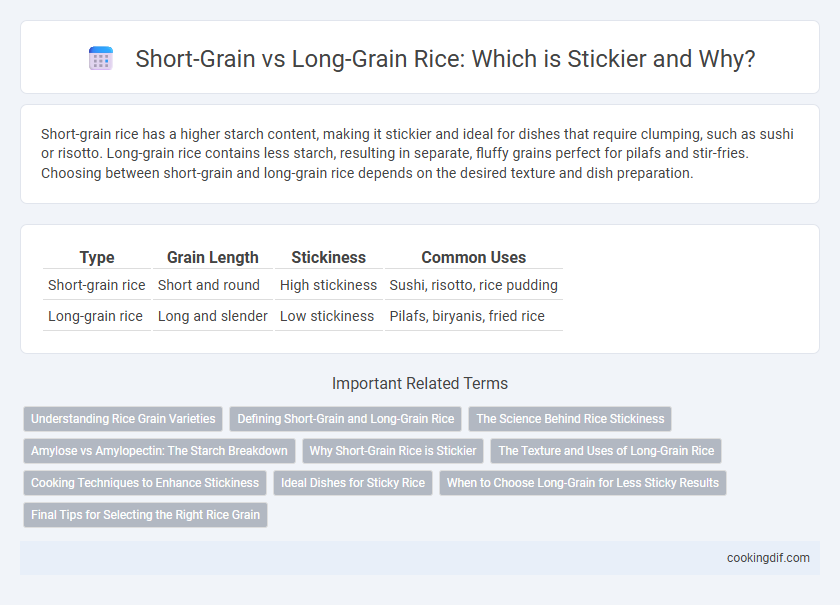Short-grain rice has a higher starch content, making it stickier and ideal for dishes that require clumping, such as sushi or risotto. Long-grain rice contains less starch, resulting in separate, fluffy grains perfect for pilafs and stir-fries. Choosing between short-grain and long-grain rice depends on the desired texture and dish preparation.
Table of Comparison
| Type | Grain Length | Stickiness | Common Uses |
|---|---|---|---|
| Short-grain rice | Short and round | High stickiness | Sushi, risotto, rice pudding |
| Long-grain rice | Long and slender | Low stickiness | Pilafs, biryanis, fried rice |
Understanding Rice Grain Varieties
Short-grain rice varieties are known for their high starch content, which results in a sticky and clumpy texture ideal for sushi and risotto dishes. Long-grain rice contains less amylopectin, making it drier and fluffier, perfect for pilafs and stir-fries where separate, non-sticky grains are preferred. Understanding the differences in starch composition between short-grain and long-grain rice is essential to selecting the appropriate variety for specific culinary applications.
Defining Short-Grain and Long-Grain Rice
Short-grain rice is characterized by its plump, almost round grains that release more starch, resulting in a sticky and clumpy texture ideal for sushi and risotto. Long-grain rice features slender, elongated grains with lower amylopectin content, which yields a fluffy, separate texture commonly used in pilafs and biryanis. Understanding the starch composition and grain shape is essential for selecting rice based on stickiness and dish requirements.
The Science Behind Rice Stickiness
Short-grain rice contains higher levels of amylopectin, a branched starch molecule that increases stickiness and results in clumping during cooking. Long-grain rice has more amylose, a linear starch that absorbs less water and remains separate and fluffy after cooking. The molecular structure of these starches directly influences the texture and stickiness, crucial for selecting rice types in culinary applications.
Amylose vs Amylopectin: The Starch Breakdown
Short-grain rice contains higher levels of amylopectin and lower amylose, resulting in a stickier texture when cooked, ideal for dishes requiring clumping grains. Long-grain rice has increased amylose and reduced amylopectin, producing separate, fluffy grains due to less gelatinization and starch breakdown. Understanding the amylose-to-amylopectin ratio is essential for selecting rice based on desired stickiness and texture in culinary applications.
Why Short-Grain Rice is Stickier
Short-grain rice has a higher amylopectin content compared to long-grain rice, which causes its grains to cling together and creates a sticky texture. The rounder shape of short-grain rice also contributes to increased surface area contact, enhancing its stickiness during cooking. This characteristic makes short-grain rice ideal for dishes like sushi and risotto where a cohesive texture is desired.
The Texture and Uses of Long-Grain Rice
Long-grain rice has a firm, fluffy texture with separate, non-sticky grains when cooked, making it ideal for dishes that require distinct grains like pilafs, salads, and fried rice. Its lower amylopectin content compared to short-grain rice prevents clumping, enhancing its suitability for stir-fries and side dishes. Common varieties include Basmati and Jasmine, prized for their aromatic qualities and versatility in diverse culinary applications.
Cooking Techniques to Enhance Stickiness
Short-grain rice naturally has higher amylopectin content, making it stickier compared to long-grain varieties, which contain more amylose and tend to be fluffier. To enhance stickiness in long-grain rice, rinsing less before cooking and using slightly less water promotes a firmer, more cohesive texture. Steaming short-grain rice after boiling further improves stickiness by evenly distributing moisture and gelatinizing starches more effectively.
Ideal Dishes for Sticky Rice
Short-grain rice is ideal for dishes requiring sticky texture, such as sushi, rice balls, and mochi, due to its higher amylopectin content that causes grains to cling together. Long-grain rice, with its lower starch and higher amylose, remains fluffy and separate, making it unsuitable for sticky rice dishes but perfect for pilafs and biryanis. Sticky rice varieties like glutinous rice are predominantly short-grain and essential for traditional Asian desserts and savory recipes needing clingy rice.
When to Choose Long-Grain for Less Sticky Results
Long-grain rice is ideal for recipes requiring fluffy, separate grains, such as pilafs and stir-fries, due to its lower amylopectin content which reduces stickiness. Choosing varieties like Basmati or Jasmine ensures a drier texture that resists clumping, perfect for dishes where grain distinction is important. Long-grain rice also cooks with less moisture absorption, helping maintain integrity in salads and side dishes.
Final Tips for Selecting the Right Rice Grain
Short-grain rice offers higher starch content, resulting in a stickier texture ideal for sushi and risotto, while long-grain rice remains separate and fluffy, perfect for pilafs and biryanis. Choosing the right rice grain depends on the dish's required texture, with short-grain enhancing creaminess and long-grain providing distinct grains. Consider cooking methods and desired stickiness to achieve optimal results tailored to specific culinary needs.
Short-grain vs long-grain for rice stickiness Infographic

 cookingdif.com
cookingdif.com